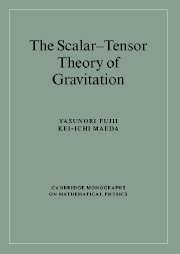Book contents
- Frontmatter
- Contents
- Preface
- Conventions and notation
- 1 Introduction
- 2 The Prototype Brans–Dicke model
- 3 Conformal transformation
- 4 Cosmology with Λ
- 5 Models of an accelerating universe
- 6 Quantum effects
- Appendix A The scalar field from Kaluza-Klein theory
- Appendix B The curvature scalar from the assumed two-sheeted space-time
- Appendix C The field equation of gravity in the presence of nonminimal coupling
- Appendix D The law of conservation of matter
- Appendix E Eddington's parameters
- Appendix F Conformal transformation of a spinor field
- Appendix G Conformal transformation of the curvature scalar
- Appendix H A special choice for conformal invariance
- Appendix J The matter energy–momentum nonconservation law in the E frame
- Appendix K A modification to the Λ term
- Appendix L Einstein's equation in the brane world
- Appendix M Dilatation current
- Appendix N Loop integrals in continuous dimensions
- Appendix O A conformal frame in which particle masses are finally constant
- References
- Index
3 - Conformal transformation
Published online by Cambridge University Press: 24 August 2009
- Frontmatter
- Contents
- Preface
- Conventions and notation
- 1 Introduction
- 2 The Prototype Brans–Dicke model
- 3 Conformal transformation
- 4 Cosmology with Λ
- 5 Models of an accelerating universe
- 6 Quantum effects
- Appendix A The scalar field from Kaluza-Klein theory
- Appendix B The curvature scalar from the assumed two-sheeted space-time
- Appendix C The field equation of gravity in the presence of nonminimal coupling
- Appendix D The law of conservation of matter
- Appendix E Eddington's parameters
- Appendix F Conformal transformation of a spinor field
- Appendix G Conformal transformation of the curvature scalar
- Appendix H A special choice for conformal invariance
- Appendix J The matter energy–momentum nonconservation law in the E frame
- Appendix K A modification to the Λ term
- Appendix L Einstein's equation in the brane world
- Appendix M Dilatation current
- Appendix N Loop integrals in continuous dimensions
- Appendix O A conformal frame in which particle masses are finally constant
- References
- Index
Summary
Once we introduce the nonminimal coupling term, we face the issue of conformal transformations. By applying a conformal transformation, we can put a nonminimal coupling term into another form. This comes from the fact that Einstein's theory is not invariant under conformal transformations. In this sense this transformation has a feature different from the gauge transformation. In the literature, however, we sometimes find confusions. We wish to provide readers with a better understanding of the issue.
We are particularly interested in how we can eliminate the factor of the scalar field in a nonminimal coupling term by transforming it into a constant. We say that we move from one conformal frame to another by applying a conformal transformation. The questions are then those concerning what conformal frame we live in, and on what physical grounds we are able to select which. An explicit discussion of these questions will be given in Chapter 4 on cosmological applications.
Among infinitely many conformal frames, the J(ordan) frame and the E(instein) frame are those discussed most frequently. Generally speaking, physics looks different in two different conformal frames. In the limit of a weak gravitational field (including a diagonalization process), however, physical conclusions remain the same.
In section 1, the concept of conformal transformation is introduced in general terms but briefly. A fact of special importance in connection with the nonminimal coupling term is discussed in section 2.
Information
- Type
- Chapter
- Information
- The Scalar-Tensor Theory of Gravitation , pp. 61 - 76Publisher: Cambridge University PressPrint publication year: 2003
